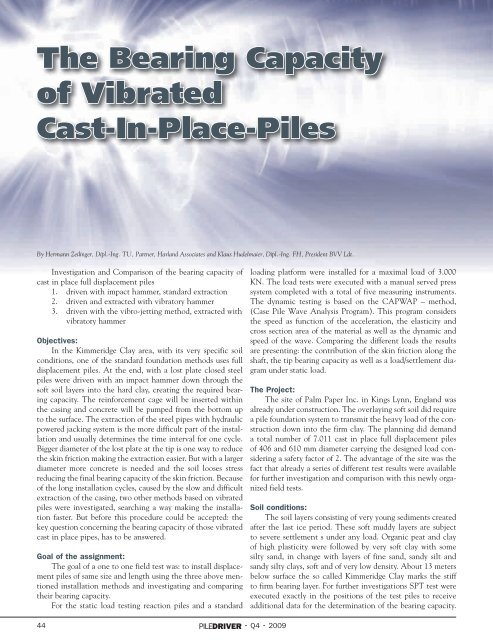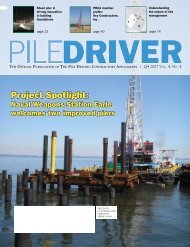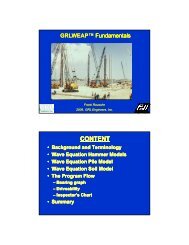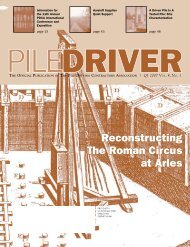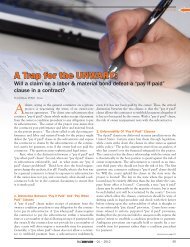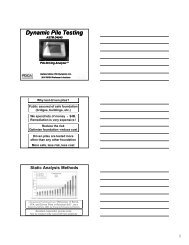Full Issue (17 MB) - Pile Driving Contractors Association
Full Issue (17 MB) - Pile Driving Contractors Association
Full Issue (17 MB) - Pile Driving Contractors Association
Create successful ePaper yourself
Turn your PDF publications into a flip-book with our unique Google optimized e-Paper software.
The Bearing Capacity<br />
of Vibrated<br />
Cast-In-Place-<strong>Pile</strong>s<br />
By Hermann Zeilinger, Dipl.-Ing. TU, Partner, Harland Associates and Klaus Hudelmaier, Dipl.-Ing. FH, President BVV Ldt.<br />
Investigation and Comparison of the bearing capacity of<br />
cast in place full displacement piles<br />
1. driven with impact hammer, standard extraction<br />
2. driven and extracted with vibratory hammer<br />
3. driven with the vibro-jetting method, extracted with<br />
vibratory hammer<br />
Objectives:<br />
In the Kimmeridge Clay area, with its very specific soil<br />
conditions, one of the standard foundation methods uses full<br />
displacement piles. At the end, with a lost plate closed steel<br />
piles were driven with an impact hammer down through the<br />
soft soil layers into the hard clay, creating the required bearing<br />
capacity. The reinforcement cage will be inserted within<br />
the casing and concrete will be pumped from the bottom up<br />
to the surface. The extraction of the steel pipes with hydraulic<br />
powered jacking system is the more difficult part of the installation<br />
and usually determines the time interval for one cycle.<br />
Bigger diameter of the lost plate at the tip is one way to reduce<br />
the skin friction making the extraction easier. But with a larger<br />
diameter more concrete is needed and the soil looses stress<br />
reducing the final bearing capacity of the skin friction. Because<br />
of the long installation cycles, caused by the slow and difficult<br />
extraction of the casing, two other methods based on vibrated<br />
piles were investigated, searching a way making the installation<br />
faster. But before this procedure could be accepted: the<br />
key question concerning the bearing capacity of those vibrated<br />
cast in place pipes, has to be answered.<br />
Goal of the assignment:<br />
The goal of a one to one field test was: to install displacement<br />
piles of same size and length using the three above mentioned<br />
installation methods and investigating and comparing<br />
their bearing capacity.<br />
For the static load testing reaction piles and a standard<br />
loading platform were installed for a maximal load of 3.000<br />
KN. The load tests were executed with a manual served press<br />
system completed with a total of five measuring instruments.<br />
The dynamic testing is based on the CAPWAP – method,<br />
(Case <strong>Pile</strong> Wave Analysis Program). This program considers<br />
the speed as function of the acceleration, the elasticity and<br />
cross section area of the material as well as the dynamic and<br />
speed of the wave. Comparing the different loads the results<br />
are presenting: the contribution of the skin friction along the<br />
shaft, the tip bearing capacity as well as a load/settlement diagram<br />
under static load.<br />
The Project:<br />
The site of Palm Paper Inc. in Kings Lynn, England was<br />
already under construction. The overlaying soft soil did require<br />
a pile foundation system to transmit the heavy load of the construction<br />
down into the firm clay. The planning did demand<br />
a total number of 7.011 cast in place full displacement piles<br />
of 406 and 610 mm diameter carrying the designed load considering<br />
a safety factor of 2. The advantage of the site was the<br />
fact that already a series of different test results were available<br />
for further investigation and comparison with this newly organized<br />
field tests.<br />
Soil conditions:<br />
The soil layers consisting of very young sediments created<br />
after the last ice period. These soft muddy layers are subject<br />
to severe settlement s under any load. Organic peat and clay<br />
of high plasticity were followed by very soft clay with some<br />
silty sand, in change with layers of fine sand, sandy silt and<br />
sandy silty clays, soft and of very low density. About 13 meters<br />
below surface the so called Kimmeridge Clay marks the stiff<br />
to firm bearing layer. For further investigations SPT test were<br />
executed exactly in the positions of the test piles to receive<br />
additional data for the determination of the bearing capacity.<br />
44 • Q4 • 2009


